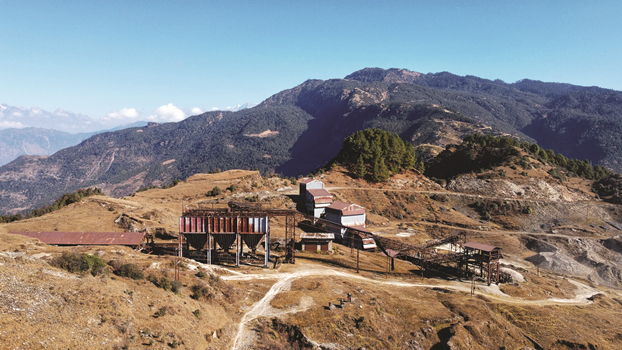Country's largest magnesite mine remains shut for 22 years

By Kailash Lama
Charikot, Dec. 4: The largest magnesite mine in Dolakha district is put off operation for more than two decades now.
Located at Bhimeshwor Municipality-9, Lakuridanda and considered as the pride of the country, the Orient Magnesite Pvt. Ltd. has remained shut for about 22 years which has affected more than 3,000 employments.
A worker used to earn as much as Rs. 4,000 a month in those days, said Ram Shrestha, a local of Bhimeshwor-9, Kharidhunga who had started working at the mine as a contractor.
"People from Dolakha, Sindhupalchowk and Ramechhap districts had got job opportunities at the company. With the closure of the mine, they all lost their jobs and the country has lost millions in revenue," he said.
The Department of Mines and Geology had found a reserve of about 180 million tons of magnesite and 300,000 tons of slate in the areas of 2.5 square kilometres. If only the high quality magnesite is used, the mine has enough reserve to produce Dead Burnt Magnesite (DBM) for more than 200 years.
Nepal had conducted the feasibility study of the site with the support of German government which recommended establishing an industry in 1973. Following the recommendations of the study, the government established Orient Magnesite in 1978 with 50 per cent equity of the government and 50 per cent of Orissa Industries Limited, India.
As pre the agreement, the management of the company was given to the Indian firm for 25 years.
According to Bhuwan KC, an employee of the industry then, the joint-venture with the Indian company was forged in order to transfer the new technology required to run the mine.
He said that the company started test production from 1987. However, the single stage firing system technology installed at the site couldn't work as per expectation. It was modified multiple times and test productions were made but it couldn't produce sellable DBM.
The plant couldn't work well due to the sub-standard technology installed at the site, said Krishna Pakhrin, a mine contractor at the industry then. He said that even the 10.5 km long ropeway constructed to transport the raw materials to the refinery installed in Balefi Rural Municipality, Lamosanghu was sub-standard and was shut down soon after it came into operation.
As the low-standard technology couldn't produce quality materials, Nepal government and International Finance Corporation had directed to shut down the industry in 1990.
Later, a study conducted by the UNDP had recommended rehabilitating the industry and the government decided to inject additional capital into the mine and take over the management by itself.
After that, the Rs. 500 million company's 75 per cent shares were owned by Nepal government, 12.5 per cent by Orissa Industries Limited and 12.5 per cent by Khetan Group, a Nepali private sector industrial conglomerate.
The raw materials were taken to Austria to test the quality. According to Refractory Consulting and Engineering (RCE) of Austria, with the raw materials from the site about 3 tons of DBM could be produced per hour with 3.2 BSG quality.
With close observation of the RCE, the plant at the site was modified and upgraded. It produced 2.5 tons of DBM per hour with the said quality.
However, the products couldn't compete with the cheaper Chinese products while the increase in the price of petroleum products pushed the price even higher. Following this, the factory was shut down again in 1998.
The 22 years of shut down has damaged the machines and equipment at the plant, said Nima Dorje Tamang, a local.
The industry has the capacity of producing dead burnt magnesite, calcine magnesite and slate powder. Dead burnt cannot be melted even at a temperature of 1,800 to 2,600 degree Celsius. It doesn't soak other matters that melt.
Calcine magnesite is used in the products like animal feed, chemical fertilisers, anti-pollution agent, medicine and incombustible partition board. These three products can be used in more than 50 different products and are in high demand in the international market.
Recent News

Do not make expressions casting dout on election: EC
14 Apr, 2022
CM Bhatta says may New Year 2079 BS inspire positive thinking
14 Apr, 2022
Three new cases, 44 recoveries in 24 hours
14 Apr, 2022
689 climbers of 84 teams so far acquire permits for climbing various peaks this spring season
14 Apr, 2022
How the rising cost of living crisis is impacting Nepal
14 Apr, 2022
US military confirms an interstellar meteor collided with Earth
14 Apr, 2022
Valneva Covid vaccine approved for use in UK
14 Apr, 2022
Chair Prachanda highlights need of unity among Maoist, Communist forces
14 Apr, 2022
Ranbir Kapoor and Alia Bhatt: Bollywood toasts star couple on wedding
14 Apr, 2022
President Bhandari confers decorations (Photo Feature)
14 Apr, 2022










